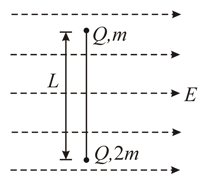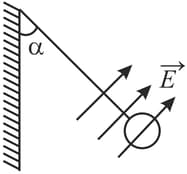B M Sharma Solutions for Chapter: Coulomb's Law and Electric Field, Exercise 7: Exercise
B M Sharma Physics Solutions for Exercise - B M Sharma Solutions for Chapter: Coulomb's Law and Electric Field, Exercise 7: Exercise
Attempt the free practice questions on Chapter 1: Coulomb's Law and Electric Field, Exercise 7: Exercise with hints and solutions to strengthen your understanding. PHYSICS for Joint Entrance Examination JEE (Advanced) Electrostatics and Current Electricity solutions are prepared by Experienced Embibe Experts.
Questions from B M Sharma Solutions for Chapter: Coulomb's Law and Electric Field, Exercise 7: Exercise with Hints & Solutions
Two small balls and of positive charge each and masses and , respectively, are connected by a non-conducting light rod of length . This system is released in a uniform electric field of strength as shown. Just after the release (assume no other force acts on the system)

A ball at is in equilibrium as it is attached with two strings and which are tied at and . The charges at and are and respectively. Find the correct options. The ball at is positively charged.

A charged cork of mass suspended by a light string is placed in a uniform electric field of strength as shown in the figure. If in equilibrium position tension in the string is , then angle with the vertical can be

The following figure shows a block of mass suspended from a fixed point by means of a vertical spring. The block is oscillating simple harmonically and carries a charge There also exists a uniform electric field in the region. Consider four different cases. The electric field is zero in case , downward in case , upward in case , and downward in case . The speed at the mean position is the same in all cases. Select the correct alternative(s).

Three charged particles are in equilibrium under their electrostatic forces only.
A simple pendulum of mass charged negatively to coulomb oscillates with a time period in a downward electric field such that If the electric field is withdrawn, the new time period

Two objects and are charged. Let charge on and charge on , then match column I and column II.
| Column I | Column II | ||
|---|---|---|---|
| (i) | a. | Charge transfer by conduction | |
| (ii) | b. | Charging by friction | |
| (iii) | c. | Charging by induction |
Let and are two identical objects of same mass initially are charged electrostatically by rubbing against each other. Let has got a positive charge and has got a negative charge, then match column I and column II.
| Column I | Column II | ||
|---|---|---|---|
| (i) | Mass of | a. | Increases |
| (ii) | Mass of | b. | Decreases |
| (iii) | Work function of | c. | Is less |
| (iv) | Work function of | d. | Is more |
